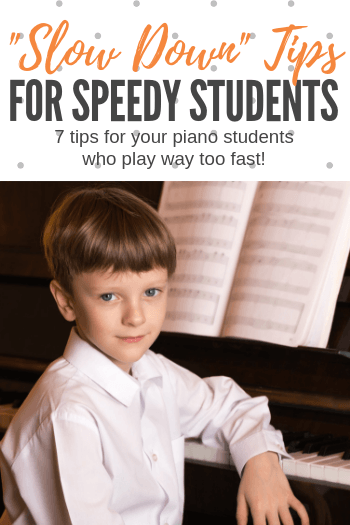Having to slow down piano students is a daily occurrence in studios! Raise your hand if you too have students who habitually race through pieces.
Since I can’t see you, I’m just going to assume that your hand is in the air.
We all teach piano students who have a tendency to play too fast (I call them Jackrabbits). And while speed may come in handy for pieces marked vivace, for most repertoire it poses a problem.

Piano Students Who Play Too Fast
Piano students who play too fast usually belong to one of three categories:
1) The Wannabe Show-off: This student is convinced that everything sounds more impressive if it is played as quickly as possible. He is only interested in repertoire that highlights his fast fingers and, when given a piece at a slower tempo, makes the editorial decision that it would still sound best fast.
2) The “Git’r Done”: This student is happy to play through her piece, but not so happy to take the time needed to include any sense of expression, phrasing, or nuance. “Play through your piece” to them literally means, “Get to the end”… rapidly!
3) The Nervous Nelly: This student plays a piece at a normal tempo during lessons and practice sessions, but races through recital performances. His fingers appear possessed as they blast through a performance piece.
How To Slow Down Piano Students
For your students to be well-rounded pianists, it is important for each of these 3 “speedsters” to gain some control over their sense of tempo. And while their fast fingers may impress some initially, eventually they are going to be called upon to play something slow… or (yikes!) accompany a singer or another instrument.
Many teachers habitually reach for the metronome when dealing with students like this, but if you are looking for metronome alternatives, check out our 7 tips to slow down piano students:
1) Resist the urge to banish them to the “Land of Largo”: As a piano teacher, it is tempting to give speedy students the slowest pieces you can find. Surely by having them play only slow repertoire their ‘internal tempo gauge’ will re-set itself? But… before you dust off your anthology of funeral marches, consider the fact that what you are hoping to achieve is an internal sense of tempo that is balanced. Therefore, to be able to effectively monitor their own playing, these students need exposure to pieces of all different tempos.
2) Create opportunities for biofeedback – Often piano students who play too fast have lost the ability to tell just how fast they are playing. They have reinforced their speedy habit so often that they actually believe they are playing at a reasonable speed. To help your students gain control over their flying fingers, use audio and video recordings so they can be aware of how they sound and/or look without having to listen as they play. Make note of stumbles, slips, and mistakes (kindly) and, using their sheet music, discuss the instances where these errors were due to their choices in tempo.
I’d also suggest searching Youtube using the term “fastest piano player in the world”. Your students will likely get a kick out of watching other Jackrabbits. It’s also a great opportunity to discuss things like “Did you find his/her performance enjoyable?” or “What kinds of things did you like or not like about the performance”. They will likely surprise you with their insights.
3) Step away from the piano: Encourage “tap practice”. It is much more difficult for your students to play too fast when they are away from the piano. It’s a great way to retrain their muscle memories to more reasonable tempos.
Read this post to learn all about Tap Practice.
4) Encourage visualization: This is so important for students who tend to play at lightening speed when performing. Teach your students to “Take 5” (5 breaths before they begin) and, during this time, to hear the first two phrases of their pieces in their minds at their practiced tempos. Only after they have mentally heard the beginning of their pieces should they start.
5) Partner up: Turn piano pieces into duets by playing alongside your students (two octaves higher). This will help them control the tempo as they are forced to keep time with you. For little ones, creating lyrics to sing along with the main melody also helps to keep them steady. Pairing your speedy students with one of their peers for duet work also works wonders… but be sure not to pair two Jackrabbits, unless you’re wanting your keyboard to burst into flames!
6) Talk about the music: For many Jackrabbits, music is music. They forget to tell the story behind the notes. Spend time discussing the storyline that could follow the music, what the composer’s motivations may have been when creating the piece, and anything else that can connect them with the piece in a way that encourages expression and nuance.
7) Use a metronome: I’ve left this one to last, as it’s the most obvious method and is the one thing that most piano teachers automatically reach for. However, using a metronome without creating an understanding of the metronome just leads to frustrations on the part of your students and the eventual ability to block out the metronome while they play. Your piano students need to understand what each of those ticks means (where in each measure they should be when they hear it) and should have spent considerable time playing very simple pieces or their scales and chords along with a metronome. It’s not a quick fix, but it is a beneficial skill to be able to play with one.
Never Fear, Steady Eddy Is Almost Here!
With a few small adjustments to how you approach your Jackrabbits, you will be able to slow down your piano students! And not only will these students then have a great internal sense of tempo and underlying beat, but they will also have built up the muscle coordination to be able to play fast when needed. Your Jackrabbits have the potential to be your stars; help them learn to monitor their own playing and watch their abilities soar!
When we created “The Adventures of Fearless Fortissimo” I had in mind, several Jackrabbit students. I knew that playing a soundtrack to a comic adventure would encourage them to think about the story behind the music and then adjust their tempo accordingly.
If you have some Jackrabbit students, check out this book series for a motivating way to tap into their expressive side!


Great article, I have a number of ‘jack rabbits’ I need to share this with
I tell my students to not play like Speedy Gonzalez!!! Lol some of them never heard of this mouse but of course I pulled him up on YouTube and showed a clip of Speedy being Speedy! Lol!
Great tips for the speedy student!
I’d love to hear more ideas about how you incorporate the metronome!
Your piano student needs to understand what each of those ticks means (where in each measure they should be when they hear it)
Hi Stacy – sounds like a good idea for a future blog post! I’m on it 🙂
Haha-I was a ‘jack rabbit’ student and it took a patient teacher and a metronome to teach me to slow down. I’ve been asking students to ‘diagnose’ the issues in a piece, and what ‘prescription’ they would apply to it. Quite often, they come up with ‘slow down’ as a plan. I also teach them that their brains can’t tell whether they’re storing right or wrong notes and when they go fast and make mistakes, they’re basically practicing mistakes-and, what you practice, you will learn’. Much easier to do it right the first time. That being said, I let them learn the notes and time without the metronome and teach them that the metronome will help them bring up the speed evenly. It’s a tool, not a crutch.
Just sent out this email to two of my upper-level “jackrabbits!”
Hi J. and G.,
You are two of my STAR students, and you also (tend to) play REALLY FAST! 🙂
I found this great article, and instead of reading it to you, or telling you about it, I thought I’d just send you the article.
Read it and try ONE idea from the article. Tell me about the idea you tried and how it went, and I’ll have a special treat for you this week! 🙂
Love, Mrs. B.
Included a link to your article in the email! 🙂